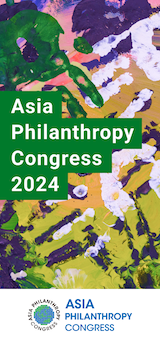Over 100,000 delegates participated in COP28 last year, making it the biggest in COP history. China also sent its largest delegation to Dubai, including over 50 foundations and NGOs, highlighting the increasing engagement of Chinese civil society in climate initiatives. SEE (The Society of Entrepreneurs & Ecology) is among these organizations. During COP28, SEE participated in and hosted a series of activities focused on youth climate leadership development, China-Arab climate action cooperation, and plastic pollution management, among others.

Beijing climate week credit: Fan Li
Established in 2004, SEE is China’s first nonprofit founded by a group of prominent entrepreneurs dedicated to ecological protection. To celebrate its 20th anniversary, SEE organized the inaugural Climate Week in Beijing this June. The event brought together diverse stakeholders from China and beyond under the theme ‘Participation of All and Innovation for a Green Future.’ WINGS was invited to facilitate a panel discussion during the parallel one-day conference, exploring the philanthropic sector’s contributions in China and other countries, innovative practices, and strategies for aligning cross-sector initiatives to maximize collective impact.
Business Sector’s Role in Climate Action
China, now the world’s largest emitter, accounted for approximately 26 percent of global CO₂ emissions in 2022. In 2021, China announced ambitious climate goals: peaking carbon dioxide emissions before 2030 and achieving carbon neutrality by 2060. This positions the business sector in a pivotal role.
Discussions during SEE Climate Week underscored significant strides made by Chinese businesses in climate action. The conference was held at Goldwind Industrial Park in the southeastern suburbs of Beijing, home to Goldwind, a leading wind turbine manufacturer. In 2023, Goldwind became the world’s top supplier of wind turbines, with Envision, another Chinese company, closely following at No. 2. China currently leads globally in renewable energy production and consumption, driven by rapid developments in solar and wind power, bolstered by substantial government subsidies throughout the 2010s. According to CarbonBrief, renewable power output in China nearly tripled between 2017 and 2022.
Alibaba’s Xianyu, China’s largest online marketplace for second-hand goods with 100 million registered users, showcased another innovative approach. Xianyu has developed its own carbon emission reduction standard, and in fiscal year 2023, its users collectively reduced carbon emissions by 3.14 million tons, averaging a daily reduction of 8,600 tons.
Strengthening Resilience Through Climate Finance and Adaptation
Asia-Pacific is one of the region’s most vulnerable to climate change, with 32.6 million people experiencing internal displacement due to climate-related disasters in 2022 alone, accounting for 70 percent of the global total. According to the IMF’s latest report, meeting climate mitigation and adaptation needs in emerging and developing Asia requires at least $1.1 trillion annually, but current investments fall short by about $800 billion. A panel on climate finance organized by AVPN emphasized the need for blended finance, which combines public, private, and philanthropic funds to address these funding gaps. Foundation representatives, researchers, and regional impact investing advisors discussed the importance of taking risks and aligning interests to make these finance models successful.
Xu Hu, Head of Research at the Chinese Academy of Financial Inclusion, pointed out that 86 percent of green financing in China is through green loans, with bonds and sustainable equity making up a smaller portion. This indicates a heavy reliance on government credit to leverage commercial capital. Clive Ye, Senior Investment Manager of Singapore-based Mana Impact, shared insights from designing and implementing blended finance projects in Southeast Asia and stressed the importance of monitoring, measuring, and reporting systems.
Patrick Yeung, Associate Director at the Climate Action Platform at AVPN, highlighted the benefits of investing in climate adaptation, which can minimize losses from climate-related events, secure incomes, and fortify supply chains. However, he also noted that these investments are still relatively new compared to carbon neutrality investment and require a thorough understanding of climate impacts across sectors.
Accelerating Collective Philanthropy
Co-organized by WINGS and Rockefeller Philanthropy Advisors, the session ‘From China to the World: Philanthropic Strategies for Climate Impact’ delved into consolidating philanthropic initiatives in China and globally for greater collective impact against climate change.
Less than two percent of global philanthropic funding goes to climate and nature. Twelve percent of this global spending comes from Asia, versus 43 percent from North America and 23 percent from Europe. Carol Tan, Deputy CEO of Asia Philanthropy Circle (APC), emphasized the importance of tangible impacts, as Asian philanthropy traditionally focuses on education and poverty alleviation. She further introduced the APC Climate Collective, a two-year program that aims to build the capacity of Asia-based philanthropists for strategic climate action and have the opportunity to engage in collaborative efforts to address climate change causes and impacts, especially in Asia.
‘China and Asia more broadly has a strong history of collectivism’, commented Heather Grady, Vice President of Rockefeller Philanthropy Advisors (RPA). SEE itself is a good example. With over 600 entrepreneur members, SEE has established a network of 31 regional project centers, supporting over 1000 NGOs and engaging nearly 900 million people in environmental protection activities.
Another leading effort of collective philanthropy in China is the China Environmental Grantmakers Alliance (CEGA). Zhang Ruiying, Director of CEGA, shared the story behind CEGA’s launch, highlighting its role as a collaborative platform for environmental grantmakers in China. In 2022, CEGA members provided approximately 284 million yuan (US$40 million) in funding to environmental charities. ‘A good platform can magnify the outcome and efforts of an individual foundation,’ commented Xie Xiaohui, Secretary General of Vanke Foundation, a founding member organization of CEGA.
Erika Miller, Climate Head of WINGS, discussed the need for foundations to integrate a climate lens into their activities, regardless of their thematic focus or size. The PhilanthropyForClimate initiative, a global movement hosted by WINGS that brings together philanthropic actions on climate from around the world, with commitments led by national philanthropy support organizations in Europe, Canada, and Brazil, and emerging ones in the Arab Region and South Africa. The movement also provides case studies and knowledge from across the world on how foundations can take action on climate, building a community of practitioners. ‘We need to look at systemic change because the problem is complex, the northern star for all of us is building evidence base to how to create greatest impact,’ said Grady.
Teaching a Man Not to Fish
Despite the Global North often setting the climate action agenda, environmental foundations and philanthropic organizations in East Asia have a long history supporting communities and movements that advocate for climate justice, adaptation, and resilience-building. China is no exception. One of the most compelling initiatives presented at the meeting was the transformation of fishermen into assistant patrol officers, a response to the ten-year fishing ban on the Yangtze River that began in 2021.
This ban, aimed at conserving the river’s ecosystem, posed significant livelihood challenges for the local fishermen. The Yangtze River Conservation Foundation has stepped in to create new employment opportunities for approximately 20,000 fishermen, reassigning them to assist in patrol work along the river. This innovative approach has had a significant impact on the health and stability of the Yangtze finless porpoise population, an important indicator of the river’s overall health.
The success of this program could serve as a model for other regions facing similar ecological and economic challenges. The transformation of fishermen into assistant patrol officers is more than just a job change; it represents a shift in how communities can engage with and protect their natural resources. This initiative has provided a lifeline for fishermen, offering them a stable income while contributing to environmental conservation. It also highlights the potential for community-driven solutions to address global environmental issues.
Another innovative grassroots adaptation action highlighted at the event was one by the Guangdong Harmony Community Foundation. Yingxin Huang, Project Officer at the Foundation, introduced its risk-based adaptation framework designed to respond to five different types of extreme weather faced by urban communities. One of the foundation’s climate risk pilot projects involves creating a risk response team that relies on extensive cooperation with local government agencies, district hospitals, local foundations, and other stakeholders.’Extreme weather events make needs of vulnerable communities more visible. For example, the third day after a heatwave is the hardest for elderly residents in urban communities,’ explained Huang. By incorporating climate action awareness and mutual support into the government’s disaster prevention and reduction system, the project has enhanced community resilience and preparedness.
Looking ahead
The discussions and initiatives presented during SEE Climate Week offered a snapshot of the innovative solutions and significant progress China and Asia are making in addressing climate change. Supported by strong government policies and innovative business practices, China’s collective action on climate change provides valuable lessons for the global community. Additionally, a recent survey introduced at the event revealed that 93.2 percent of China’s Generation Z, approximately 260 million strong, supports international cooperation on climate change, which suggests that there is a promising future driven by youth engagement.
From a philanthropic perspective, the key takeaway is the urgent need for philanthropic actors of all sizes—from China, Asia, and around the world—to understand each other’s approaches and collaborate. Rather than fostering competition and scarcity mindsets, collective action and innovative solutions are essential for creating a green future for all.
Fan Li is the East Asia advisor for WINGS and the East Asia regional representative for Alliance






Comments (0)